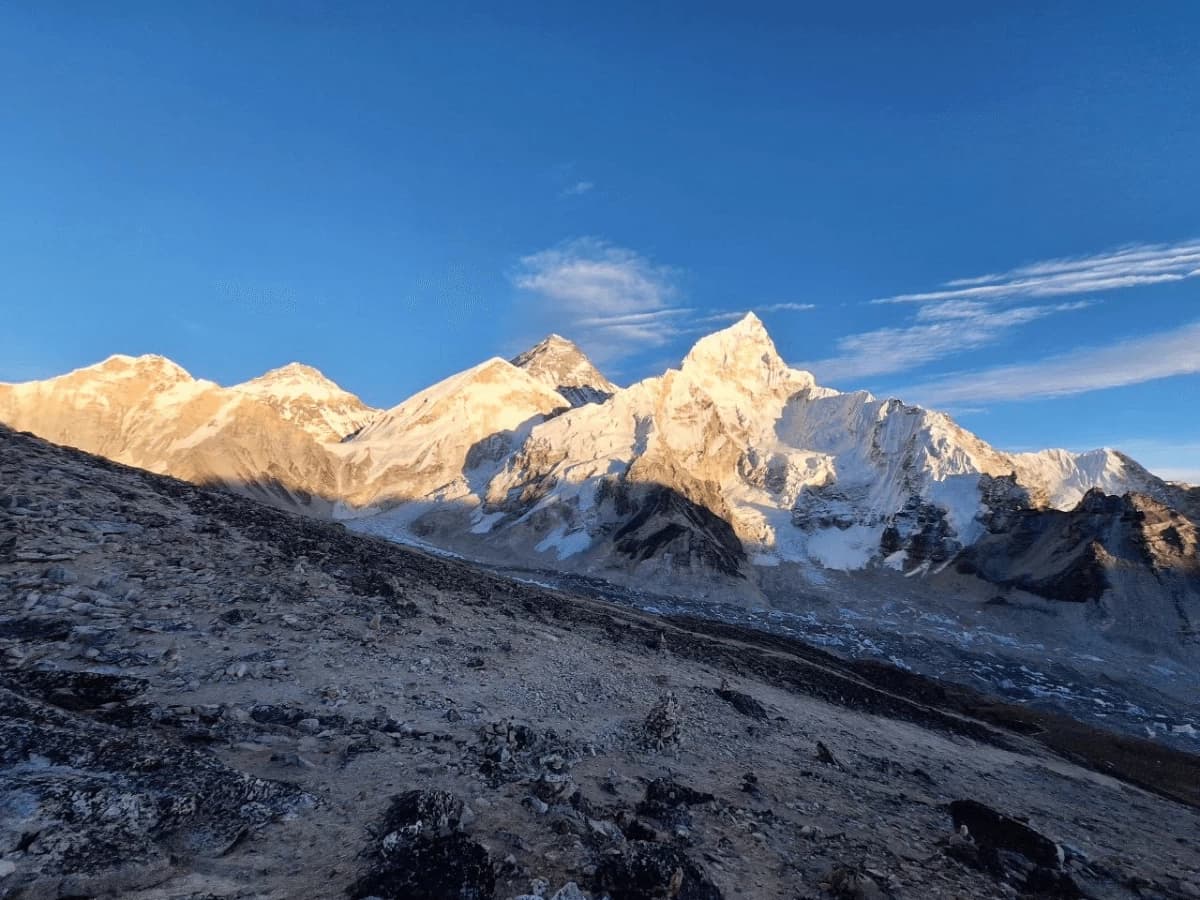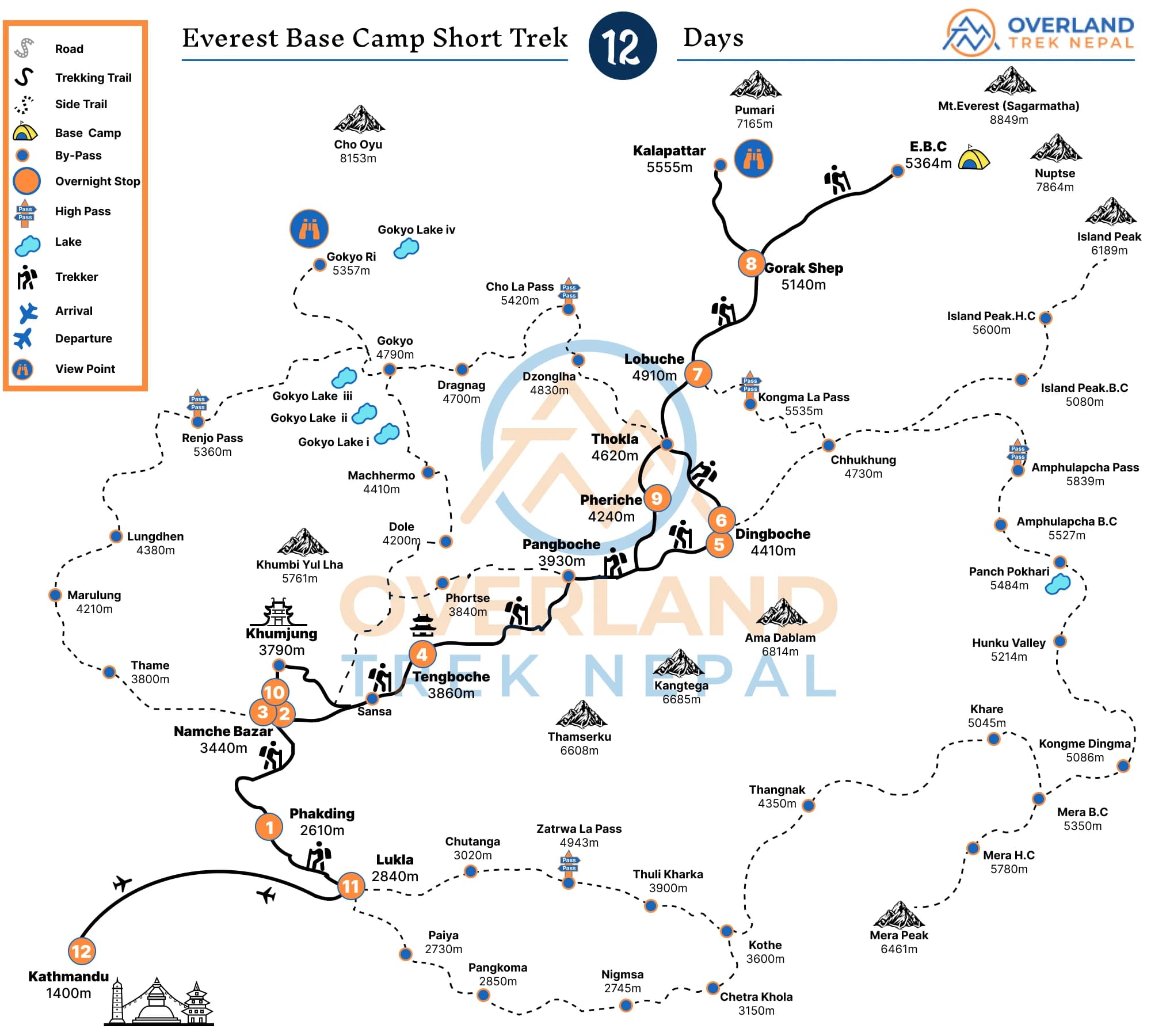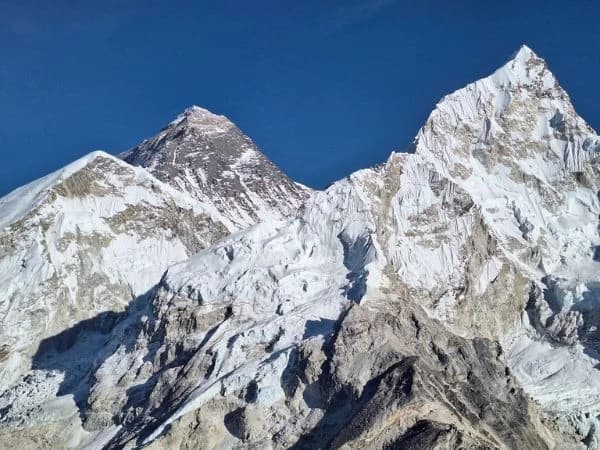Major Highlights to See during the EBC Trek
- All-around views of Mount Everest, Lhotse, Nuptse, Ama Dablam, Pumori, and others from the Kala Patthar Hike.
- Exclusive sights of Khumbu Ice Fall and Khumbu Glacier from the EBC.
- Hike to Everest Base Camp, an iconic place to be at the foothills of the highest peak in the world.
- Excellent opportunity to closely look at the lifestyle of the Sherpa People.
- Stroll around the Monasteries, villages, and chortens along the journey.
- A diverse range of wild flora and fauna is found inside the Sagarmatha National Park, a UNESCO World Heritage Site.
Comprehensive Overview of the Everest Trek
Everest Base Camp Short Trek in 12 Days is an exotic journey into the Khumbu Region, marching in the footsteps of Iconic Tenzing Norgay Sherpa and Edmund Hillary. Bounded by some of the highest peaks, including Mount Everest (8848.86m), this journey displays rich Sherpa Culture, a wide variety of flora & fauna, snow-capped peaks, tranquil villages, glaciers, icefalls, and many more charms. Besides all these alluring charms of this trek, the magisterial views of Mount Everest, Ama Dablam, Pumori, Lhotse, Nuptse, etc., stand as the best part.
Our Short Everest Trek is an ideal package for those who have a very limited time and can’t cover our 14-day EBC Trek. This 12-day Everest Base Camp Trek Itinerary is moderately difficult, taking you to the maximum height of 5545 meters at Kala Patthar. Though it is a carefully customized itinerary, it requires good physical and mental condition to enjoy the expedition to EBC and Kala Patthar. Beginners need top preparation to do this trek without any hassle. Meanwhile, experienced trekkers can do this trek to enhance their trekking journey.
Unlike the Everest Three High Passes Trek, this expedition to the EBC takes less than 2 weeks to complete and discover the magic of the Khumbu Region. Likewise, the bustling town of Namche Bazaar and the famous Tengboche Monastery are always in the sights of visitors. Also, the Everest Bungee, which has been recently invented,d has caught the eyes of a lot of trekkers. If you are a daring person to test your limits on this adventure, then give it a try. This Everest Journey with Bungee could be your lifetime experience and a story that you can tell to your grandchildren.
Is the Everest Base Camp Trek Worth it?
Once you start the journey at the right time, every moment of the EBC is worth it. The trek delivers more than you have imagined. Every year, when thousands of trekkers travel to Nepal, it is their dream to glimpse Mount Everest. Then, wander through this legendary Everest Base Camp Trek Route, navigating the historical villages, Monasteries, valleys Sherpa Settlements, Sagarmatha National Park, etc., to witness the highest peak in the world. Every penny of your money is worth it once you hop onto that plane from Kathmandu to Lukla. Even the flight from Kathmandu-Lukla will give you the taste of the beautiful Himalayas, you will admire for the next 12 Days of the Everest Base Camp Trek.
Kala Patthar Hike vs Everest Base Camp Hike
Both Kala Patthar Hike and Everest Base Camp Hike are part of the Everest Base Camp Short Trek. Also, both hike starts from the beautiful Gorakshep Village, the final camp of the EBC Trek. It takes around 2 hours to climb Kala Patthar, covering 1.2 Km from Gorakshep. The top of the Kala Patthar provides a breathtaking panorama of Mount Everest, Lhotse, Nuptse, Pumori, Ama Dablam, and many others. Meanwhile, the Everest Base Camp Hike is around 4.3 Km from Gorakshep, which takes around 3-4 hours to reach. You can witness glacial moraines and other peaks from the base camp. However, the views of Mt. Everest from the base camp are hard to see.
How difficult is it for beginners to do the Short Everest Base Camp Hike?
Reaching the top of the Everest Base Camp is often challenging if you are a beginner. This kind of high-altitude expedition requires enough physical and mental effort to cover 8-12 Km daily. Hence, for a beginner with a lack of preparation, it is always going to be a tough journey. Rugged trail during the Hike to Kala Patthar, 4-5 nights over 4500 meters, and altitude sickness can be major problems for novice trekkers.
Therefore, pre-trek preparations and practices are very essential if you are a first-time hiker. Jogging, gym workouts, day hiking, cycling, eating the right food, and packing essential clothes ensure your trekking flexibility. Also, guided trekking provides even more convenience and moral support in case of difficulties. Our Sherpa Trekking Guide will provide you with enough information on how to tackle the difficulties, using an acclimatization day, and lead you to EBC safely. Everest Base Camp Trek Preparation is equally crucial before heading to the foothills of Mount Everest.
12 Days Itinerary of a Short Trek to Everest
The Everest Base Camp Trek 12 Days Itinerary starts with a flight from Kathmandu to Lukla via Rammechhap. The starting day can be a little rush as you have to drive to Ramechap from Kathmandu in the middle of the night to catch the flight. After a 30-minute flight to Lukla, the team will take a short break to ensure all the members are ready and head towards Phakding. From here, the Pathway follows the route of Namche, Tengboche, Dingboche, Lobuche, and Gorakshep. The village of Gorakshep is the final stop before hiking to Everest Base Camp and Kala Patthar. Cherish the moments of magic of the highest peaks from these places and hike down to Pangboche, Namche, and lastly, Lukla to end the fascinating trip to Everest.
Best Price of Short Everest Base Camp Trekking in 2025, 2026
The total Short Everest Base Camp Trekking price depends on the pathway, services, transportation, facilities during the trek, and so on. Usually, the EBC Trek Cost ranges from USD 1099 to $5500. However, the cost can vary once you tailor your itinerary and the service you would like to have during the trek.
Overland Trek Nepal offers you a 12-day Everest Base Camp Trek at USD 1349 per person. The cost includes Everest Trekking Permit Fees, accommodation during the trek, domestic flights, ground transportation, meals during the trek, a guide, a porter, and government taxes. Apart from that, personal expenses like drinks, hot water, showers, Wi-Fi, charging devices, etc. are not part of the package.
Do you know, you can do the EBC Trek with Island Peak Climbing?
Wow, knowing that you can do Peak Climbing in Nepal along with Trekking to the Iconic EBC can give you goosebumps. You heard it right, Island Peak Climbing with EBC can be possible for adventure enthusiasts who want to experience trekking and climbing in the Khumbu Region. It requires a significant amount of determination, time, climbing skills, and mental toughness. Despite its challenges, the views from the top of the Island Peak are unmatched. If you have at least 21 days in Nepal and challenge yourself to the mountains, this trip is a go-to expedition that can create an unforgettable trekking experience.
Why the Overland Trek Nepal is Best Trekking Company in Nepal for the EBC Trek?
Overland Trek Nepal has been actively leading the trekking groups to the foothills of the highest peak in the world, Mt. Everest. Our expert trekking guide of the Everest Region will provide you with the required guidance to complete this trek without any fuss. Here are why you should do the Three High Passes Trek with us:
- Knowledgeable trekking guide with experience of more than 10 years.
- Everest Base Camp Trekking Route Map.
- Complimentary Duffel Bag, T-shirts, and Sun Hat of Overland Trek Nepal
- Nepali SIM Card.
- Free Luggage storage at our Office throughout the trip.
- First Aid Kit carried by the guide.
- Necessary arrangement of a Helicopter rescue if needed.
- 24-hour communication with trekking leaders.
- Trekkers Massage for an hour after the end of the trek.
Participate in our 12-day Everest Base Camp Trek Itinerary & get the most out of the Khumbu Region. To know more about this journey, feel free to reach out to us via email or WhatsApp at +9779851138871.





















